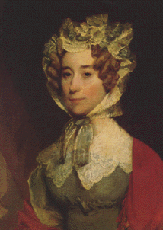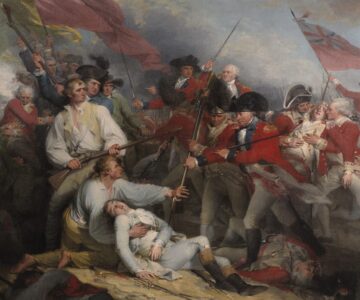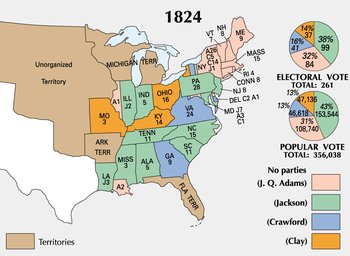Basic Facts:
Birth: July 11, 1767 at Quincy Mass.
Death: February 23, 1848 at Washington, D. C.
Married: July 26, 1797 to Louisa Catherine Johnson (1775-1852)
Children: Four – George Washington, John II, Charles Francis, Louisa Catherine
President: One term beginning March 4, 1825
Quote: “The four most miserable years of my life were my four years in the presidency.”
Family:
 Adams spent the winter of 1795–1796 in London, where he met Louisa Catherine Johnson, his future wife. They married in 1797. Adams and Louisa had three sons and a daughter.
Adams spent the winter of 1795–1796 in London, where he met Louisa Catherine Johnson, his future wife. They married in 1797. Adams and Louisa had three sons and a daughter.
First son, George, and second son, John (1803–1834), led troubled lives and died in early adulthood. Their daughter, Louisa, died in infancy.
- They named their first son George Washington Adams (1801–1829) after the first president. He was born in Berlin, Prussia. George Adams served in the Massachusetts House of Representatives and on the Boston City Council. George, who had long suffered from alcoholism, died in 1829 after going overboard on a steamboat; it is not clear whether he fell or purposely jumped from the boat. George and his brothers Charles and John were all rivals for the same woman, their cousin Mary Catherine Hellen, who lived with the John Quincy Adams family after the death of her parents. In 1828, John Adams II married Mary Hellen at a ceremony in the White House, and both his brothers refused to attend. George fathered an out-of-wedlock child with a mistress, Eliza Dolph, who was the chambermaid to Dr. Thomas Welsh, the Adams family’s Boston doctor. She had a child in December 1828.
- John Adams II was born July 4, 1803. When John Quincy Adams became president, his son served as his private secretary. He ran an unprofitable flour and grist mill owned by his father. In 1828 John married Mary Hellen at a ceremony in the White House, which both his brothers refused to attend. John Adams II and Mary Hellen were the parents of two daughters, Mary Louisa (December 2, 1828 – July 16, 1859) and Georgiana Frances (September 10, 1830 – November 20, 1839).
According to Wikipedia:
At a White House reception during the John Quincy Adams presidency, Russell Jarvis, an anti-Adams reporter for the Washington Daily Telegraph, believed that President Adams publicly insulted Mrs. Jarvis. Since the President was considered to be immune from a dueling challenge, Jarvis attempted to initiate a duel with John Adams II, who had been at the reception. Jarvis’s effort to provoke an incident led to a highly publicized fistfight in the Capitol Rotunda, with Jarvis pulling the hair and nose of and slapping Adams, and Adams refusing to retaliate. An investigating committee of the United States House of Representatives determined that Jarvis had initiated the attack, but took no other action. Louisa Adams always believed that the negative press generated by this incident, with John Adams II being accused of cowardice by newspaper editors who supported Andrew Jackson, led to Adams’ early demise. The attack on Adams was the impetus for Congress to establish the United States Capitol Police, which provides security for Congressional buildings and grounds.
Like his brother, John also abused alcohol and he died of an unknown illness in 1834. Mary Hellen Adams continued to reside with John Quincy and Louisa Adams and helped care for them in their old age. She died in Bethlehem, New Hampshire on August 31, 1870
- Adams’s youngest son, Charles Francis Adams Sr., (1807-1886) was an American historical editor, writer, politician, and diplomat. He was an important leader of the “Conscience Whigs”, a Northern, anti-slavery faction of the Whig Party. Charles served as the Free Soil Party’s vice presidential candidate in the 1848 presidential election with Martin Van Buren and later became a prominent member of the Republican Party. During the Civil War, Adams served as the United States Minister to the United Kingdom under Abraham Lincoln. In 1870 he built the first presidential library in the United States to honor his father, John Quincy Adams.
Other:
The life of John Quincy Adams, sixth President, cannot be considered without reference to his father, John Adams, second President of the U. S.
John Quincy was born to John and Abigail Adams in 1767, the second of six children, four of whom survived to adulthood.

Battle of Bunker Hill by John Trumbull
In 1778, at age ten, he and his brother Charles, 8, accompanied their father to France and the Netherlands where John Adams tried to negotiate military and financial aid for the new republic.
At fourteen, in 1781, he traveled to Russia as private secretary to Francis Dana, the first American diplomat to the Russian court. He stayed in Russia for two years.
In 1783 he returned to the Netherlands and then to Great Britain the following year with his father.
In 1785 he came home (he had not seen his mother for eight years) to attend Harvard, graduating in 1787 at age 20.
From 1789-1797 John Adams was Vice-President in the administration of George Washington.
In 1794, President George Washington appointed John Quincy Adams as the U.S. ambassador to the Netherlands.
Following the election of Thomas Jefferson in 1801, John Quincy Adams returned to the U. S. He was elected state senator for Massachusetts in 1802 and as U. S. Senator in 1803. He resigned in 1807 and was appointed by President Madison as Minister to Russia.
Adams held diplomatic posts for the duration of Madison’s presidency, and he served as part of the American delegation that negotiated an end to the War of 1812.
In 1817, newly elected President James Monroe selected Adams as his Secretary of State. In that role, Adams negotiated the Adams–Onís Treaty, which provided for the American acquisition of Florida. He also helped formulate the Monroe Doctrine, which became a key tenet of U.S. foreign policy.
 The 1824 presidential election was contested by John Quincy Adams, Andrew Jackson, William H. Crawford, and Henry Clay, all of whom were members of the Democratic-Republican Party. As no candidate won a majority of the electoral vote, the House of Representatives held a contingent election to determine the president, and Adams won that contingent election with the support of Clay.
The 1824 presidential election was contested by John Quincy Adams, Andrew Jackson, William H. Crawford, and Henry Clay, all of whom were members of the Democratic-Republican Party. As no candidate won a majority of the electoral vote, the House of Representatives held a contingent election to determine the president, and Adams won that contingent election with the support of Clay.
As President, John Quincy Adams called for an ambitious agenda that included federally funded infrastructure projects, the establishment of a national university, and engagement with the countries of Latin America, but many of his initiatives were defeated in Congress.
During Adams’s presidency, the Democratic-Republican Party polarized into two major camps: one group, known as the National Republican Party, supported President Adams, while the other group, known as the Democratic Party, was led by Andrew Jackson. The Democrats proved to be more effective political organizers than Adams and his National Republican supporters, and Jackson decisively defeated Adams in the 1828 presidential election, the second president (after his father) to fail re-election.
Rather than retiring from public service, Adams won election to the House of Representatives, where he would serve from 1831 to his death in 1848. He remains the only ex-president to be elected to the chamber (although John Tyler was elected a Confederate representative, but died before he could take his seat).
Other Facts:
President Adams regularly swam nude in the Potomac River. Anne Royall, the first American professional journalist, knew of Adams’ 5 A.M. swims. After being refused interviews with the president time after time, she went to the river, gathered his clothes and sat on them until she had her interview. Before this, no female had interviewed a president.
Adams was the first to be elected president without receiving either the most popular votes or the most votes of the electoral college.
He was the first president married abroad. Louisa Adams was America’s only foreign-born First Lady (until Melania Trump).
Adams was the first president to be photographed.
Adams is the only president to be elected to the House after his presidency.
John Quincy Adams is reported to have been 5’7″ tall, the same as his father, John Adams.
In a study conducted in 2008, a fitness chain concluded that John Quincy Adams was the fittest president in American history, thanks to his habit of walking more than three miles daily and swimming in the Potomac River during his presidency.
He reportedly spoke eight foreign languages (English, Latin, Greek, French, German, Spanish, Italian, Dutch, and Russian). It has been suggested that John Quincy Adams had the highest I.Q. of any U.S. president. Dean Simonton, a professor of psychology at UC Davis, estimated his I.Q. score at 165.
First Lady Louisa Adams raised silkworms and spun their silk. They also owned an alligator, said to have belonged to Marquis de Lafayette and housed for two months in the East Room.
Adams also argued a case before the Supreme Court—and won. On July 1, 1839, the illegally abducted slaves aboard The Amistad seized the ship, killing the captain and cook, and directing the surviving crew to return them to Africa. Instead, they sailed north, where the ship was seized by U.S. officials. Fights over property rights ensued, in which the slaves asserted their freedom. U.S. v. The Amistad was appealed all the way to the Supreme Court, where Adams argued on behalf of the slaves. The Court ruled in their favor, with Justice Joseph Story writing the opinion for a 7-1 majority.
At age 78, in 1846, Adams suffered a stroke while on the House floor. He mostly recovered—though he was left partially paralyzed—and returned to service within a few months. Two years after the stroke, on February 21, 1848, Adams collapsed during a debate about the Mexican-American War. He died two days later.
Return to The Presidents main page.
Sources:
Internet Public Library
Wikipedia
Constitution Center.org
New England Historical Society.com
Greenman, Barbara. The Timeline History of U. S. Presidents and First Ladies. Thunder Bay Press, 2009.
